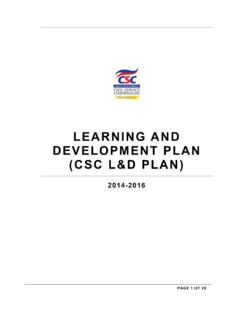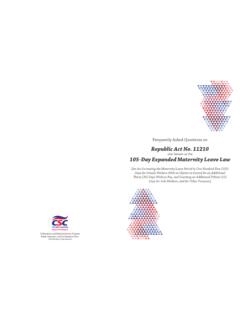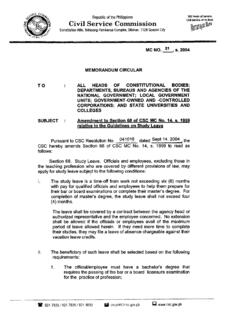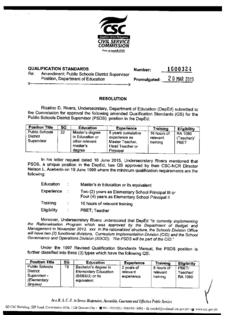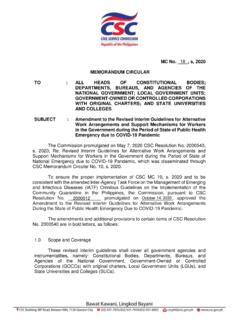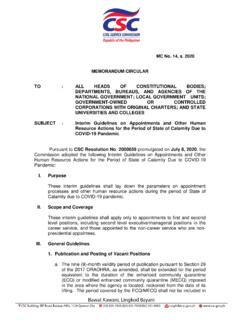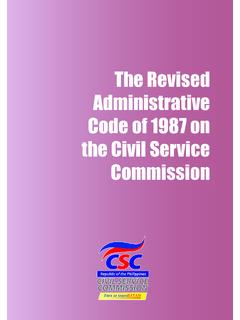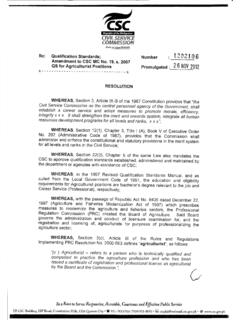Transcription of COMPETENCY-BASED LEARNING AND DEVELOPMENT …
1 PAGE 1 OF 43 COMPETENCY-BASED LEARNING AND DEVELOPMENT MANAGEMENT SYSTEM IN THE CIVIL SERVICE COMMISSION INTRODUCTION This document is divided into two parts: the standards, and process and procedures for LEARNING and DEVELOPMENT (L&D). Part I provides the L&D Philosophy, Curriculum Framework and minimum standards in the implementation of L&D interventions and initiatives for the officials and employees in the CSC. It articulates the guiding principles of CSC in developing its people to ensure that all L&D interventions contribute meaningfully to the efficient, effective and ethical achievement of CSC s strategic objectives and goals pursuant to its mandates under the Constitution and the Administrative Code of 1987, as implemented though the Integrated Results-Based Performance Management System, Performance Governance System (PGS) and the Strategic Performance Management System (SPMS).
2 Part II documents the step-by-step process and procedures that will guide L&D implementers in the DEVELOPMENT , provision, coordination, delivery and evaluation of L&D activities of CSC officials and employees. It aims to serve as a guide in systematically translating CSC s strategic objectives for human resource DEVELOPMENT (HRD) into operational plans, such that CSC will be able to: Identify priority competency DEVELOPMENT targets/needs of officials and employees; Provide and plot L&D interventions that are appropriate to bridge the gaps, enhance competencies, improve job performance, increase productivity and develop the CSC workforce to manage efficiently and competently the changes and challenges in the CSC; Ensure that the Office for Human Resource Management and DEVELOPMENT (OHRMD)and the Human Resource Division (HRD) of the Civil Service Regional Offices (CSROs) follow a process that will align individual DEVELOPMENT goals to the goals of the CSC.
3 And Give the management, supervisors and individuals the opportunity to keep track of the plans to develop and maintain the competencies of CSC workforce. COVERAGE The standards, process and procedures intend to cover the following: 1. All L&D programs for CSC officials and employees delivered, arranged, purchased and/or outsourced by the OHRMD, HRD of the CSROs, the Civil Service Institute (CSI) and other Central Office units of the CSC; and 2. All phases of the L&D process adopted by the CSC, which begins from the COMPETENCY-BASED LEARNING needs assessment, design, delivery to evaluation. PAGE 2 OF 43 PART I COMPETENCY-BASED LEARNING AND DEVELOPMENT STANDARDS Chapter 1 CSC s LEARNING and DEVELOPMENT Philosophy The CSC adheres to the overall L&D philosophy -- Shaping the Servant-Hero towards Public Service Excellence.
4 The goal is to align all L&D interventions to CSC s mission and strategic objectives as it strives to become Asia s Leading Center of Excellence for Strategic Human Resource and Organizational DEVELOPMENT by 2030. The CSC L&D philosophy affirms the organization s overall focus on creating an excellent and high-performing organization through its people supporting the following strategic objectives in the CSC Balance Scorecard: High Performing, Competent, and Credible Civil Servants; Provide Excellent HR Processes; Enhance the competency of our Workforce; and Cultivate Partnerships with Local and International Institutions. Emphasizing that women and men in the organization matter, the CSC s aim is always to create significant changes in the workplace through programs that help CSC officials and employees: Strengthen mission-critical competencies particularly those of strategic groups such as the executives/managers, supervisors and HR practitioners; Develop the right capabilities, perspectives and mindset required to contribute meaningfully to the efficient, effective and ethical achievement of CSC s strategic priorities and to work harmoniously with others and with respect for women and men s rights; and Improve their self-knowledge and human potentials and strengthen their employability.
5 L&D interventions and initiatives in the CSC shall be hinged on the following overall principles: 1. Every CSC official and employee is an important resource valued by the organization. The CSC gives priority and invests on L&D of every official and employee. 2. L&D interventions for CSC officials and employees shall be purposive and aligned with the CSC strategic objectives and goals. L&D is a means to upgrade the capability and expertise of CSC to address and respond to the multi-faceted HRD/HRM/OD needs of PAGE 3 OF 43 the civil service. L&D shall be based on DEVELOPMENT needs as determined by competency assessment and performance assessment exercises. L&D shall likewise consider the differentiated needs of women and men in the organization to ensure equitable access to L&D interventions. 3. L&D shall focus on the DEVELOPMENT , improvement or enhancement of competencies required by the current or future position/job of the official/employee.
6 4. L&D is a shared responsibility of the management, supervisors and the employees. While CSC provides the nurturing and enabling environment by opening up opportunities, among others, employees and their respective supervisors have an equal responsibility to plan and manage their DEVELOPMENT and career by determining, seeking and seizing available opportunities. 5. CSC regards investment for LEARNING and DEVELOPMENT as equally important as investments in researches, information technology (IT), purchase of equipment and product DEVELOPMENT . Capacity DEVELOPMENT of CSC officials and employees is given equal, if not a paramount importance in terms of allocating resources. Partnership with other institutions shall be explored to supplement existing resources for L&D. 6. L&D shall be designed to increase the portability of skills of employees.
7 This, therefore, requires an approach or various approaches that will allow Heads of Offices and/or supervisors to easily recognize skills which may be transferable between jobs and/or assignments. 7. Continuing upgrading of competencies is essential to the maintenance of a corps of professional officials and employees of the Commission. It aims to develop a competent, credible, and high performing CSC workforce. Continuing competence is maintained and enhanced through lifelong LEARNING and integration of LEARNING into every facet of a Commission official or employee s working life. 8. L&D shall drive performance management. It shall integrate recognition and rewards mechanism as a strategy to ensure LEARNING application in everyday work settings. PAGE 4 OF 43 Chapter 2 Curriculum Framework The establishment of the CSC competency Model and Framework determined the position profile of CSC.
8 This provides the basis for the L&D interventions appropriate to levels of positions or job families, as follows: Building-Block Programs Given the above curriculum framework, the CSC adopts a building-block approach to the delivery of its L&D programs. Basic courses are set to provide a foundation for future interventions during the employee s life cycle in the organization. This building-block approach addresses not only the current LEARNING needs but also the career DEVELOPMENT of employees. Leadership Competencies Technical Competencies Organizational Competencies Core Competencies Executive Level Supervisor A Supervisor B Second Level Non-Supervisors First Level Non-Supervisors PAGE 5 OF 43 The following matrix provides a menu, which is a combination of training programs and other L&D interventions, to help employees navigate through current and future posts over a period of employment with the CSC.
9 From 0-1 year More than 1 year to 5 years From assumption - continuing New Entrants First Level Second Level Middle Management (SupvgPS, DCs and their equivalent positions) Executive/ Managerial (DII, III, IV, AsCom) Orientation Program for New Entrants (OPEN) -3 days Improving Planning and delivery (IPAD) -2 days Supervisory DEVELOPMENT Program Management/ Executive and Leadership DEVELOPMENT Program Gender Sensitivity Seminar (GSS) -1 day Solving Problem and Making Decision (SPMD) - 3 days _____ Championing and Applying Innovation (CAI) -3 days Honing Effective and Responsive Officers towards Excellent Service (HEROES) -3 days Basic Communication Training Program Basic Communication Training Program (AO I, Stat I, Sec Ofr I) Delivering Personal Effectiveness (DPE) -2 days Advance Communication Training Program Strategic Human Resource Course (3 days) Managing Information Continuing Coaching Conferences Legal Practitioners Conference Accountants & Budget Officers Conference, Executive Conference (Strategic and Operational Planning Exercises, among others) CNet Conference, GAD Focal Point System (GFPS) Conference HR Symposium Other technical/professional conferences and colloquia, including International Conferences PAGE 6 OF 43 Aside from the above, CSC allows the following interventions to address specific LEARNING needs.
10 Formal Classroom Training On-the-Job-Training Self- DEVELOPMENT Developmental activities/interventions In-House training on <topic> External training on <topic> Coaching on the job from <supervisor/senior colleague> Knowledge sharing and LEARNING session on <topic> Shadowing under the stewardship of <person> Cross-posting Program, job rotation or rotational assignment or temporary assignment to <function> Interventions such as counseling, secondment, team building Programmed self-study through a third party provider, including self-study video or audio packages Working on eLearning courses, PC tutorials or computer assisted training program or webinar on <topic> Taking evening or weekend courses on <topic> Tertiary courses run by academic/educational institutions Reading books and other publications or journals on <topic> Special work project on <topic> Added responsibilities on <technical competency or work assignment> Service on technical or research committees, Task Force or Committee assignment on <area>sanctioned by the Commission, other professional bodies or organizations Appropriate educational and developmental activities presented under the auspices of CSC, academic/educational institutions, commercial establishments or other professional bodies such as but not limited to congresses, conferences, forums, conventions, courses, seminars, workshops, lectures, brown bag discussions, orientations.
